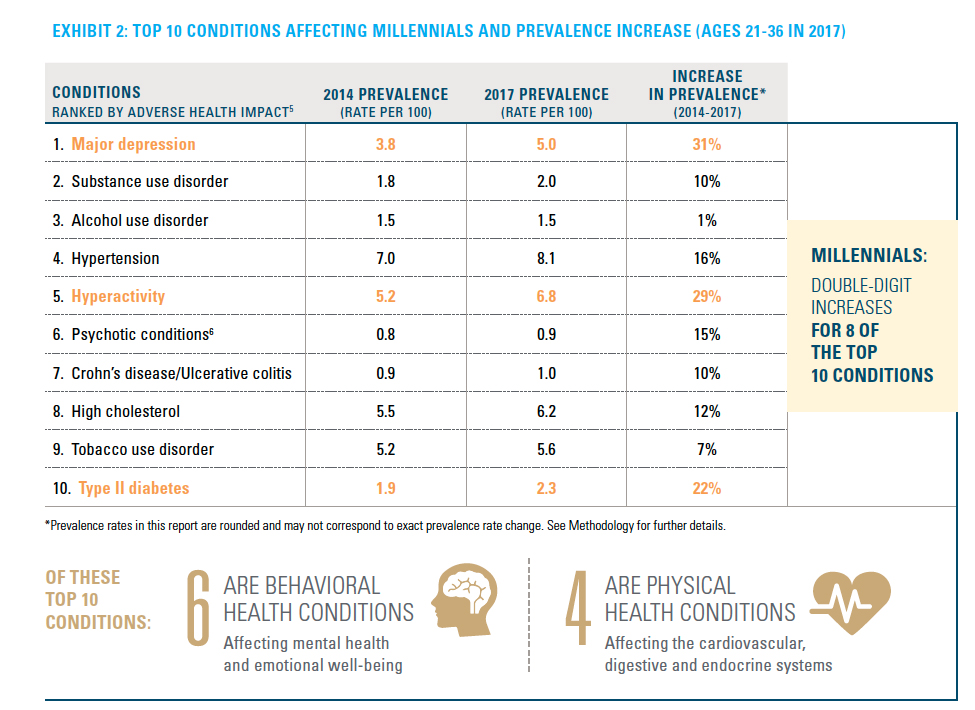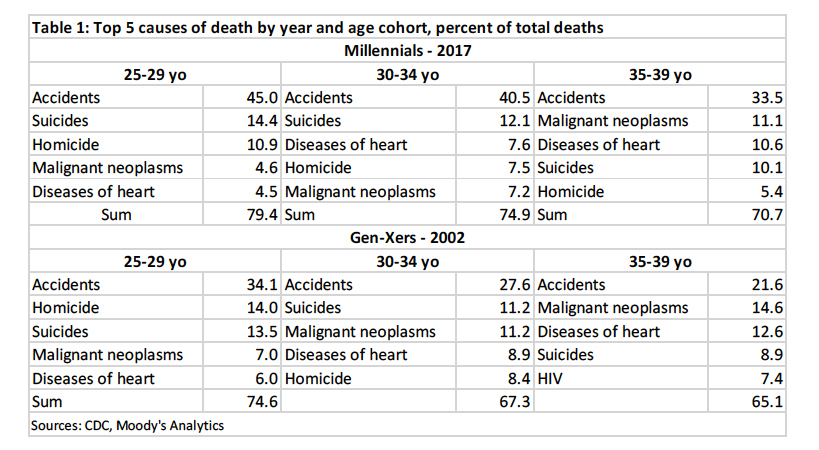A recent report [1] from Blue Cross Blue Shield (BCBS) casts both light and shadow on the current health status of the increasingly important replacement for the Boomers, the Millennials - individuals born between 1981-1996, approximately 73 million. The report covers the 75% of millennials with commercial insurance. Let us start with the good news.
- Millennials had an average BCBS Health Index of 95.1, meaning millennials as a group were living at about 95% of their optimal health
- 83% consider themselves in excellent or good health
- 68% have a primary care physician
 With the good news out of the way, the report considers the growing “crisis,” the Millenials’ declining health. Here is their “stage-setting” graphic. The ideal line would be straight across from 100 to some future age – a healthy life with few impairments. It is undoubtedly a dramatic picture and caption. (27 is the Millennial’s average age.) Without a vertical scale going to zero, we have no real visual sense of what constitutes a major decline. By way of comparison, the average Health Index for all “covered” lives is 91.5 [2].
With the good news out of the way, the report considers the growing “crisis,” the Millenials’ declining health. Here is their “stage-setting” graphic. The ideal line would be straight across from 100 to some future age – a healthy life with few impairments. It is undoubtedly a dramatic picture and caption. (27 is the Millennial’s average age.) Without a vertical scale going to zero, we have no real visual sense of what constitutes a major decline. By way of comparison, the average Health Index for all “covered” lives is 91.5 [2].

The report then identifies the “alarming” increase prevalence of the “Top 10 conditions affecting millennials.” Reporting relative rather than absolute changes to make the figures more impactful. Consider hyperactivity, demonstrating a 29% relative increase, in absolute terms a 1.6% change - a much lower value that may reflect a random fluctuation around the mean rather than an increase at all.
Hyperactivity and tobacco use disorder are specific to the Millennials, replaced by coronary artery disease, and chronic obstructive pulmonary disease for the older age groups.
The incidence of disease has a temporal pattern, e.g., infectious diseases are most prevalent in the younger and older years, as well as varying with gender, reproductive, and endocrine issues predominately involve women in their 20’s and 30’s. [3] The finding that most conditions of the millennials at this age are behavioral is consistent with those patterns. The 8% increase incidence in behavioral disease is again a relative number, the absolute increase 0.18% - is it a trend or artifact? The 20% greater adverse health for millennial women, driven by major depression, Type 2 diabetes, and other endocrine disorders, likewise echo the disease patterns found in earlier generations and not confined solely to millennials.
The BCBS’s presentation of data on mortality for millennials and gen-Xers comparison group is a hot mess.

For the two easily recognized health problems, cancer, and heart disease, millennials are healthier.
|
|
Malignant Neoplasm |
Heart Disease |
||||
|
|
25-29 |
30-34 |
35-39 |
25-29 |
30-34 |
35-39 |
|
Gen-Xers 2002 |
7.0 |
11.2 |
14.6 |
6.0 |
8.9 |
12.6 |
|
Millenials 2017 |
4.6 |
7.2 |
11.1 |
4.5 |
7.6 |
10.6 |
|
Difference |
-2.4 |
-4.0 |
-3.5 |
-1.5 |
-1.3 |
-2.0 |
Millennials are also less likely to be victims of homicide. For mental health, including behavioral problems, the data is less clear. Depression, a medical condition, is lost in the suicide, and the increase in opioid-related overdose deaths, which have dramatically increased, are obscured in accidents. [4] Teasing the numbers out, mental health issues appear higher for this generation.
To project the impact of the higher incidence of these diseases over the next few years, the authors developed two scenarios. The baseline (BL), in which many of these health shocks are transient and return to a baseline over ten years, and an adverse scenario (AD) where the current rates continue unchecked. Again, their graphics serve to confuse more than enlighten.

Let’s reformat displaying absolute change and take the temporal patterns of disease into account.
|
|
Men |
|
Women |
||||
|
|
|
Change |
|
|
Change |
||
|
Condition |
2017 (%) |
Baseline 2027 |
Worst-case scenario 2027 |
|
2017 |
Baseline 2027 |
Worst-case scenario 2027 |
|
Hypertension |
25.05 |
0.69 |
4.69 |
|
19.89 |
0.61 |
4.16 |
|
High Cholesterol |
25.54 |
0.24 |
4.24 |
|
17.36 |
0.17 |
4.09 |
|
Diabetes II |
6.35 |
0.01 |
1.29 |
|
7.15 |
0.09 |
1.87 |
|
Crohn’s/colitis |
0.41 |
0.01 |
0.08 |
|
0.52 |
- 0.02 |
0.06 |
|
|
|
|
|
|
|
|
|
|
Major depression |
3.89 |
0.24 |
0.67 |
|
8.50 |
0.37 |
1.24 |
|
Tobacco Use |
8.17 |
- 0.41 |
1.07 |
|
8.06 |
- 0.35 |
0.76 |
|
Hyperactivity |
3.60 |
-0.09 |
1.73 |
|
4.51 |
0.03 |
1.98 |
|
Substance Abuse |
1.93 |
-0.08 |
0.20 |
|
1.55 |
0.01 |
0.05 |
|
Alcohol abuse |
2.07 |
0.01 |
-0.26 |
|
1.14 |
0.04 |
-0.10 |
|
Psychotic conditions |
0.31 |
0.04 |
-0.08 |
|
0.32 |
0.02 |
-0.08 |
The study is correct in signaling concern over hypertension, cholesterol, and diabetes because those diseases do increase with age, so earlier onset translates into more individuals affected. If temporal patterns are a reasonable guide, the baseline case, showing slight absolute increases, will be closer to the truth than the worst-case scenario for the other conditions. Millennials are already at the peak time of onset for Crohn’s hyperactivity, alcohol abuse, and psychosis course; there is no reasonable belief that the incidence will increase as modeled in the adverse case. But the peak onset of major depression occurs in the mid 30’s so the adverse model may be more accurate.
The report does us a service in pointing out a possible rise in mental health issues, but it obscures that fact with unwarranted fear about double-digit increases in disease.
[3] A chronological map of 308 physical and mental health conditions from 4 million individuals in the English National Health Service Lancet Digital Health DOI: 10.1016/S2589-7500(19)30012-3
[4] The opioid-related deaths are a “health shock” that seems to be impacted this generation in the same way that HIV deaths were a health shock to an earlier generation.

